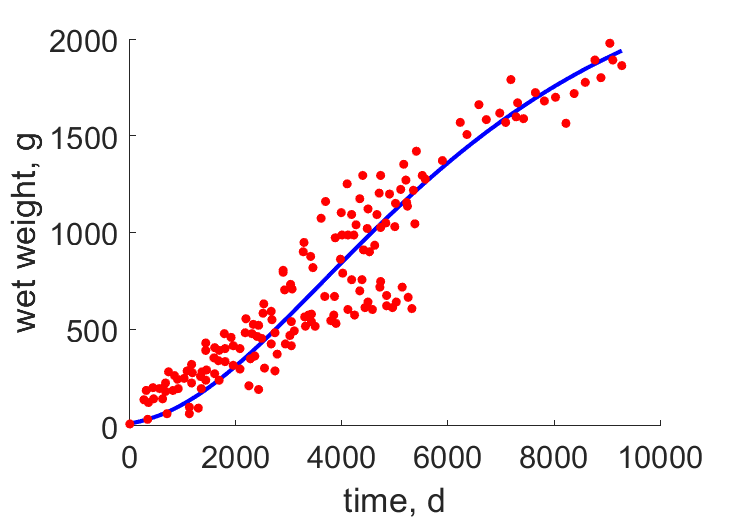Predictions & Data for this entry
| Model: std | climate: Csa | migrate: | phylum: |
| COMPLETE = 2.5 | ecozone: THp | food: biH | class: |
| MRE = 0.133 | habitat: 0iTh | gender: Dtmf | order: |
| SMSE = 0.034 | embryo: Tt | reprod: O | family: |
Zero-variate data
| Data | Observed | Predicted | (RE) | Unit | Description | Reference |
|---|---|---|---|---|---|---|
| ab | 90 | 102.9 | (0.1433) | d | age at birth | ADW |
| ap | 4560 | 4103 | (0.1002) | d | age at puberty for female | AnAge |
| am | 1.157e+04 | 1.157e+04 | (1.798e-05) | d | life span | AnAge |
| Lp | 10 | 12.61 | (0.2607) | cm | total length at puberty for females | ADW |
| Li | 23 | 18.24 | (0.2068) | cm | ultimate total length for females | ADW |
| Wwb | 12.8 | 12.27 | (0.04115) | g | wet weight at birth for female | guess |
| Wwi | 2500 | 2489 | (0.004521) | g | ultimate wet weight | ADW |
| Ri | 0.03836 | 0.03816 | (0.005069) | #/d | maximum reprod rate | EoL |
Uni- and bivariate data
| Data | Figure | Independent variable | Dependent variable | (RE) | Reference |
|---|---|---|---|---|---|
| tW |  | time | wet weight | (0.1923) | RitzClau2012 |
Pseudo-data at Tref = 20°C
| Data | Generalised animal | Testudo hermanni | Unit | Description |
|---|---|---|---|---|
| v | 0.02 | 0.03299 | cm/d | energy conductance |
| kap | 0.8 | 0.6643 | - | allocation fraction to soma |
| kap_R | 0.95 | 0.95 | - | reproduction efficiency |
| p_M | 18 | 5.109 | J/d.cm^3 | vol-spec som maint |
| k_J | 0.002 | 0.0001934 | 1/d | maturity maint rate coefficient |
| kap_G | 0.8 | 0.7979 | - | growth efficiency |
| k | 0.3 | 0.2977 | - | maintenance ratio |
Discussion
- In view of low somatic maintenance, pseudodata k_J = 0.002 1/d is replaced by pseudodata k = 0.3
Facts
- If eggs develop mostly in males between 31.5 and 33.5 C, at 31.5 and 34 C the sex ratio is 50/50 (Ref: ADW)
- Males are smaller than females and reach puberty earlier (Ref: Wiki)
Bibliography